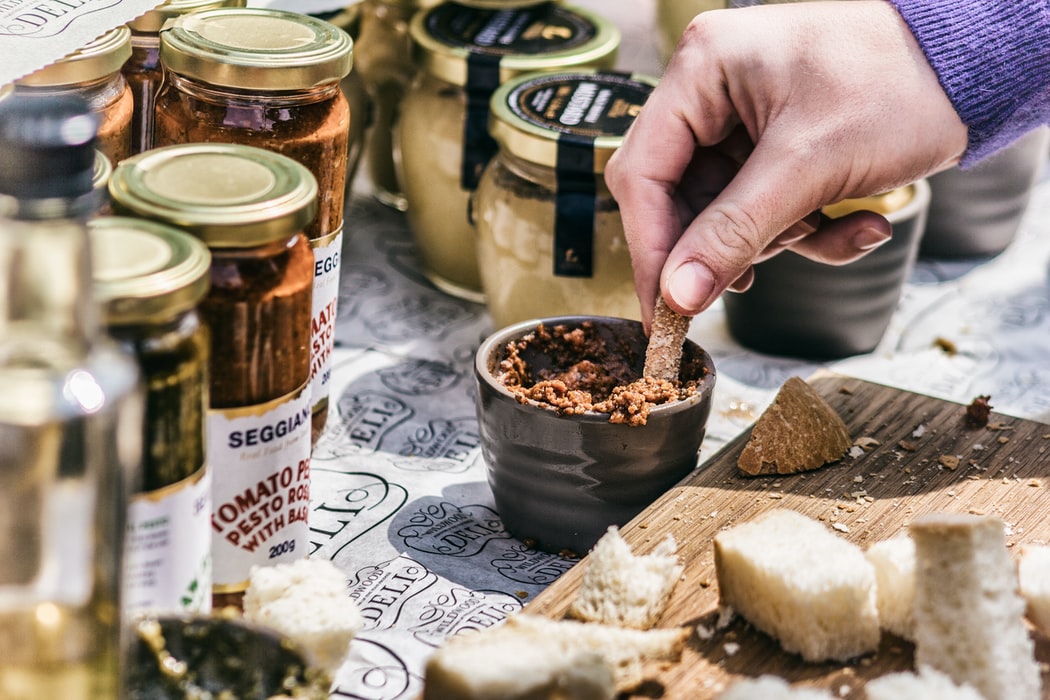The classic pesto, or pesto alla genovese, is made with pine nuts, garlic, parmesan, fresh basil and olive oil. The name of the famous sauce comes from the Italian verb “pestare”, which means “crush” or “crush”. The word clearly characterizes the cooking technology, but not the composition of the dish, which gives a certain freedom. Perhaps that is why culinary experts love to experiment with sauce ingredients so much. Instead of basil, parsley, spinach or cilantro are often added, and expensive pine nuts are exchanged for more affordable walnuts and almonds, sometimes even seeds are used.
Different regions of Italy also have their own variations of pesto, and in this article we want to talk about the most interesting varieties from an editorial point of view.
When did pesto appear?
The homeland of the sauce is in Liguria – the northern region of Italy. But to be more precise, pesto alla genovese, as its name suggests, was invented in Genoa.
The first written mention of the dish was recorded in a book about Ligurian cuisine at the end of the 19th century, although it was definitely invented much earlier.
Most likely, pesto comes from the ancient Roman snack moretum. It was made with salted cheese, garlic, olive oil, vinegar and herbs and was used as a spread on bread.
The sauce may also have appeared as an improved version of the medieval agliata (agliata) – a hot seasoning made from crushed garlic, rusks, vinegar, salt and pepper.
The first recipe, noted in a 19th century cookbook, used to include much more garlic in pesto. Apparently, this was done in order to keep it longer. Genoa has always been a port city, and local sailors often took their favorite snacks with them on their voyages. By the way, thanks in large part to sailors, Genoese sauce has become popular all over the world.
Traditional Ingredients
The well-known pesto alla genovese has absorbed the best gifts of the Italian region, so in Genoa, the selection of ingredients is very strict.
For the sauce, only young and fresh basil leaves without stems are collected. Liguria has specialized in the cultivation of this spicy plant for a long time, and it has always been available to local residents.
Pine nuts must first be fried in a dry pan or dried in the oven. This is done so that the nuts become slightly oily and better chopped.
In the Genoese recipe, of course, there is Parmigiano-Reggiano cheese from Emilia Romagna, to which sometimes cheese from sheep’s milk is added – pecorino sardo or pecorino romano.
Young garlic is chosen because it tastes less bitter.
Coarse sea salt contributes to better grinding of the remaining ingredients, and when manually preparing the sauce, they take it.
To give the sauce the desired consistency, use only unrefined extra virgin olive oil.
Pesto alla genovese
Let’s move on to the classic recipe. Ideally, the ingredients in the pesto should be ground with a wooden pestle in a marble mortar. The blender can heat the ingredients, which will adversely affect the taste. However, making the sauce by hand is difficult, so here are two useful tips: Before using the blender, put the blender bowl in the refrigerator for 15 minutes and then punch the ingredients in short pulses so that they don’t get hot.
Ingredients:
fresh basil – 80 g
Extra Virgin olive oil – 90 ml
grated parmesan cheese – 30 g
grated pecorino cheese – 30 g
pine nuts – 30 g
garlic – 2 cloves
coarse salt – 0.5 tsp.
Cooking method:
Pre-fry the pine nuts in a dry frying pan.
Rinse the basil and pat dry with a paper towel. Separate the leaves from the stems; the stems themselves are not needed.
First, grind the garlic in a blender. Add pine nuts, chop until pasty.
Add the basil leaves in two steps and season with salt. Grind until smooth.
Add grated parmesan and pecorino. If it is not possible to find pecorino cheese, you can use Parmesan, then this cheese will need 60 g. Pour in a little olive oil. Grind.
Adjust the thickness of the sauce with olive oil: the amount may vary.
What is pesto eaten with? Thanks to its versatile taste, it goes well with many dishes. Most often, the sauce is added to the pasta, while diluting with the water in which it was cooked. Also served with meat, chicken, fish or spread on sandwiches.
The finished sauce can be stored in the refrigerator for about three days. To do this, put the seasoning in a glass jar, and pour plenty of olive oil on top and close the lid tightly.
Pesto alla trapanese
Pesto alla trapanese originated on the island of Sicily in the province of Trapani. Apparently, the Genoese sailors introduced the Sicilians to the sauce. The people of Trapani have slightly modified the recipe, adding ingredients typical of their area: almonds and fresh tomatoes.
Ingredients:
tomatoes – 250 g
fresh basil – 50 g
almonds – 50 g
grated pecorino cheese or parmesan – 30 g
Extra Virgin olive oil – 50 ml
garlic – 1 clove
coarse sea salt – to taste
freshly ground black pepper – to taste
Cooking method:
For pesto alla trapanese, it is best to use peeled almonds. To remove the skins, dip the nuts in boiling water and blanch for about 1–2 minutes. Then drain the water, place the almonds on a flat surface and pat dry with a towel. When the nuts are cool, the skins can be easily peeled off by hand.
Now prepare the tomatoes. Dip the tomatoes in boiling water for 2-3 minutes. Remove with a slotted spoon and cool. Then, remove the skin from each tomato.
Grind the almonds in a blender bowl.
Add tomatoes, stalkless basil leaves, and garlic. Grind until smooth.
Add the grated pecorino, stir and transfer to a bowl. Season with salt and pepper, adjust the thickness of the sauce with olive oil. Done!
Pesto alla trapanese has a fragrant and delicate taste. Good for bruschetta and goes well with all types of pasta.
Pesto rosso
Another recipe from Sicily. Almonds are also added here, but sun-dried tomatoes are taken instead of fresh tomatoes. Roasted peppers are optional.
Ingredients:
sun-dried tomatoes in oil – 150 g
fried pepper – 1 pc.
fresh basil – 30 g
grated parmesan – 50 g
almonds – 30 g
garlic – 2 cloves
Extra Virgin olive oil – 100 ml
salt to taste
freshly ground black pepper – to taste
chili flakes – to taste
Cooking method:
Separate the basil leaves from the stems, rinse, dry.
Peel the almonds.
Put sun-dried tomatoes, fried peppers, almonds, garlic, and basil leaves in a blender bowl. Grind into a paste.
Add grated parmesan and chili flakes. Punch until smooth.
Taste, salt and pepper. Pour in olive oil and stir.
The sauce goes well with poultry and grilled meats.
Pesto agli agrumi
Agrumi means citrus and agli means garlic. From the name it is immediately clear what exactly the sauce is made of. This interesting equivalence of pesto was also given to the world by the Sicilian island.
Ingredients:
fresh basil – 80 g
almonds – 30 g
garlic – 1 clove
lemons – 1 pc.
oranges – 1 pc.
grated parmesan – 40 g
Extra Virgin olive oil – 80 ml
salt to taste
black pepper – to taste
Cooking method:
Use a peeler to gently zest the lemon and orange. Be careful not to touch the white layer, otherwise the sauce will taste bitter.
Boil the almonds in boiling water for about 1 minute, then dry and peel them.
Remove the basil leaves from the branches, rinse, dry.
Place lemon and orange zest, peeled garlic, almonds and grated parmesan in a blender bowl. Squeeze out the juice of half a lemon and half an orange. Grind.
Then add the basil and pour in the olive oil, salt and pepper. Punch again with a blender until smooth.
Use this sauce for pasta or serve with baked chicken wings.
Pesto modenese
The name of the next type of sauce was given by the city of Modena, located in the Italian region of Emilia-Romagna. This is the most unusual recipe in our collection. Pesto modenese is made from lard, a mixture of herbs and garlic.
Ingredients:
lard – 250 g
rosemary – 3 sprigs
garlic – 2 cloves
Cooking method:
Peel and cut the garlic into small pieces.
Remove the rosemary leaves from the stems and discard the stems themselves.
Place the garlic on a cutting board and crush it with a knife blade. Place the rosemary leaves on top of the garlic. Chop everything very finely with a knife, mixing constantly. If you have a mezzaluna – a crescent knife, then use it.
Grind the bacon in a blender until a pasty mass is formed or chop finely with a knife.
Stir in the garlic mixture with a fork.
Pesto modenese is ready!
Store in refrigerator for 2 weeks and remove half an hour before use.
This appetizer is ideal as a hearty spread on bread and tortillas.

